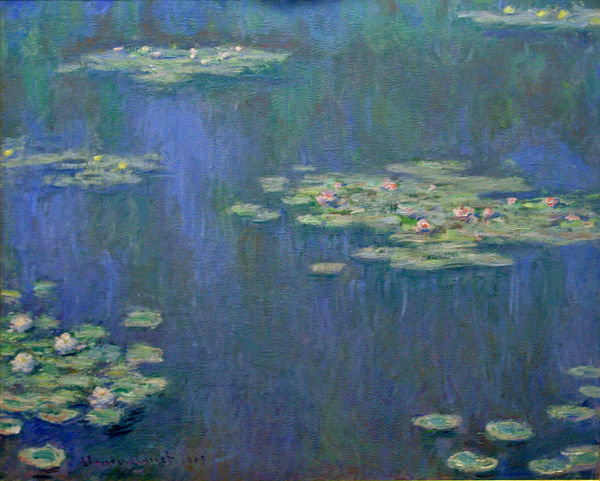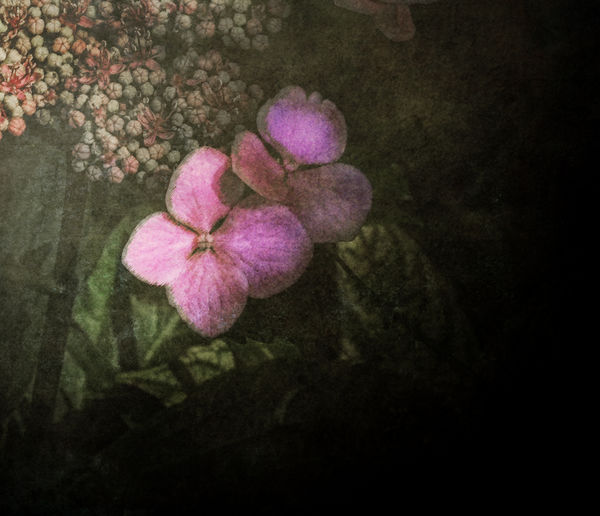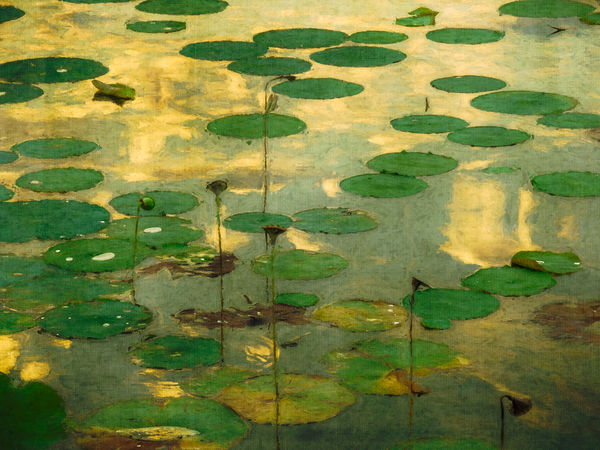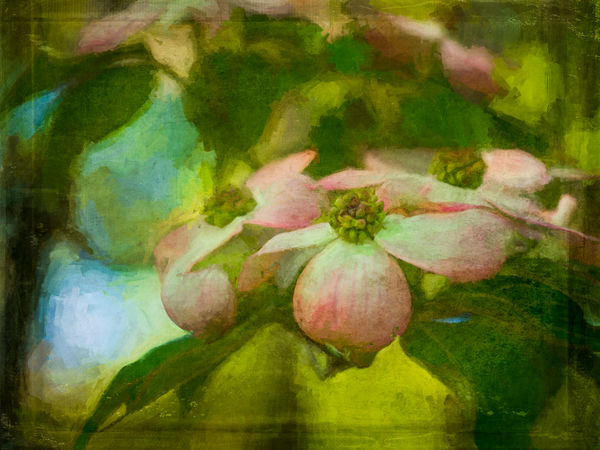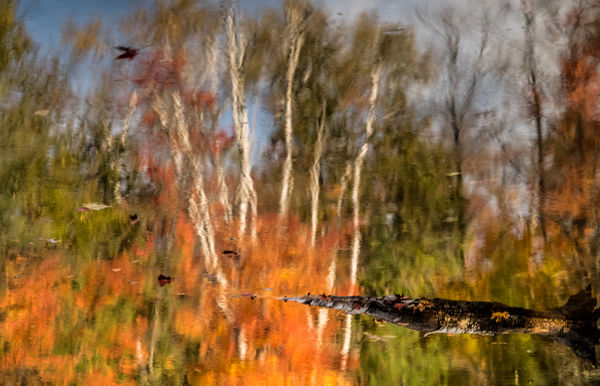Monthly Masters' Critique - May 2019 - Monet's Water Lilies
May 1, 2019 07:15:39 #
Introduction
This month we will look at one of the famous water lily paintings by Claude Monet, the French painter whose work gave a name to the art movement Impressionism. Monet was born on in 1840, in Paris, France. After an art exhibition in 1874, a critic insultingly dubbed Monet's painting style "Impression," since it was more concerned with form and light than realism, and the term stuck.
Monet gained financial and critical success during the late 1880s and 1890s, and started the serial paintings for which he would become well-known. In Giverny, he loved to paint outdoors in the gardens that he helped create there. The water lilies found in the pond had a particular appeal for him, and he painted several series of them throughout the rest of his life. As he grew older, his eyesight became impaired, and considerable discussion has surrounded the impact the advancing cataracts had on his work. (Many of us can relate to that dilemma). Monet struggled with depression, poverty and illness throughout his life. He died in 1926.
As you consider this artwork from a critical perspective, you can review some of the resources linked below, which include some short videos, histories, and analyses. Here are some questions to guide your thinking. Respond to any or all as you see fit, or pursue some other line of discussion.
Questions to Consider:
1. What do you think of the composition? The colors? The detail? The depth of field? Would you want this painting on your wall? Why or why not?
2. In what ways does Monet’s work influence or inform photography? Are there places in the world of photography for impressionistic work? Explain your thoughts.
3. Look at some of the other images in the long series of water lily paintings. What changes do you note in the body of work over time? Do you think his visual problems influenced his work? Explain your thinking. (Bonus points if you’ve dealt with visual problems yourself and can tell us whether/how these problems influenced your own work.)
4. There is controversy around every corner about the thin line between photography and other arts. For some photographers, editing photos to make them more like paintings is inherently wrong. Yet, software companies make considerable profit from programs like Topaz Impression that do just that. What is your opinion of such undertakings, and do you indulge in them? If so, would you share an image you’ve edited in an impressionistic manner.
5. There are also ways to use specific shooting strategies to capture an impressionistic type image SOC. Have you ever attempted this? If so, can you explain how you did it and share a sample resulting from this undertaking?
Links for Further Study
https://en.wikipedia.org/wiki/Water_Lilies_(Monet_series)
https://www.artic.edu/artworks/16568/water-lilies
https://www.claude-monet.com/waterlilies.jsp
https://www.moma.org/collection/works/80220
https://www.khanacademy.org/humanities/becoming-modern/avant-garde-france/impressionism/v/monet-les-nymph-as-the-water-lilies-1918-26
https://www.musee-orangerie.fr/en/article/claude-monets-water-lilies
http://www.visual-arts-cork.com/paintings-analysis/water-lilies-monet.htm
This month we will look at one of the famous water lily paintings by Claude Monet, the French painter whose work gave a name to the art movement Impressionism. Monet was born on in 1840, in Paris, France. After an art exhibition in 1874, a critic insultingly dubbed Monet's painting style "Impression," since it was more concerned with form and light than realism, and the term stuck.
Monet gained financial and critical success during the late 1880s and 1890s, and started the serial paintings for which he would become well-known. In Giverny, he loved to paint outdoors in the gardens that he helped create there. The water lilies found in the pond had a particular appeal for him, and he painted several series of them throughout the rest of his life. As he grew older, his eyesight became impaired, and considerable discussion has surrounded the impact the advancing cataracts had on his work. (Many of us can relate to that dilemma). Monet struggled with depression, poverty and illness throughout his life. He died in 1926.
As you consider this artwork from a critical perspective, you can review some of the resources linked below, which include some short videos, histories, and analyses. Here are some questions to guide your thinking. Respond to any or all as you see fit, or pursue some other line of discussion.
Questions to Consider:
1. What do you think of the composition? The colors? The detail? The depth of field? Would you want this painting on your wall? Why or why not?
2. In what ways does Monet’s work influence or inform photography? Are there places in the world of photography for impressionistic work? Explain your thoughts.
3. Look at some of the other images in the long series of water lily paintings. What changes do you note in the body of work over time? Do you think his visual problems influenced his work? Explain your thinking. (Bonus points if you’ve dealt with visual problems yourself and can tell us whether/how these problems influenced your own work.)
4. There is controversy around every corner about the thin line between photography and other arts. For some photographers, editing photos to make them more like paintings is inherently wrong. Yet, software companies make considerable profit from programs like Topaz Impression that do just that. What is your opinion of such undertakings, and do you indulge in them? If so, would you share an image you’ve edited in an impressionistic manner.
5. There are also ways to use specific shooting strategies to capture an impressionistic type image SOC. Have you ever attempted this? If so, can you explain how you did it and share a sample resulting from this undertaking?
Links for Further Study
https://en.wikipedia.org/wiki/Water_Lilies_(Monet_series)
https://www.artic.edu/artworks/16568/water-lilies
https://www.claude-monet.com/waterlilies.jsp
https://www.moma.org/collection/works/80220
https://www.khanacademy.org/humanities/becoming-modern/avant-garde-france/impressionism/v/monet-les-nymph-as-the-water-lilies-1918-26
https://www.musee-orangerie.fr/en/article/claude-monets-water-lilies
http://www.visual-arts-cork.com/paintings-analysis/water-lilies-monet.htm
May 1, 2019 09:53:12 #
Coincidentally, I have a photo of lily pads, with a single flower, on my bathroom wall. The color scheme in the room is green and blue, so yes, I would be quite willing to replace my sooc, ten-year old photo for this Monet 
I'm ignorant education-wise about Impressionism or any other styles, but I very much enjoy many of the paintings and photos, especially the soft focus (or deliberately blurred) and shallow dof flowers, trees and waterscapes.
Re photography, I'm of the "it's your image, do what you want to it" crowd (see the link in my signature line), and have been enjoying the exploration of creative editing for several years, so for me there is no controversy.
The below photo is nearly straight out of camera. I was using both motion blur (slow shutter speed) and zoom blur. As anyone who has tried these effects will attest, there's a great deal of luck involved
I have a few that might fit your topic that I worked extensively in pp. I wasn't thinking "Impressionism" at the time, so I think for now I'll not post, but will instead attempt a more deliberate result.
Thanks so much for your work every month on these topics, Minnie!

I'm ignorant education-wise about Impressionism or any other styles, but I very much enjoy many of the paintings and photos, especially the soft focus (or deliberately blurred) and shallow dof flowers, trees and waterscapes.
Re photography, I'm of the "it's your image, do what you want to it" crowd (see the link in my signature line), and have been enjoying the exploration of creative editing for several years, so for me there is no controversy.
The below photo is nearly straight out of camera. I was using both motion blur (slow shutter speed) and zoom blur. As anyone who has tried these effects will attest, there's a great deal of luck involved

I have a few that might fit your topic that I worked extensively in pp. I wasn't thinking "Impressionism" at the time, so I think for now I'll not post, but will instead attempt a more deliberate result.
Thanks so much for your work every month on these topics, Minnie!
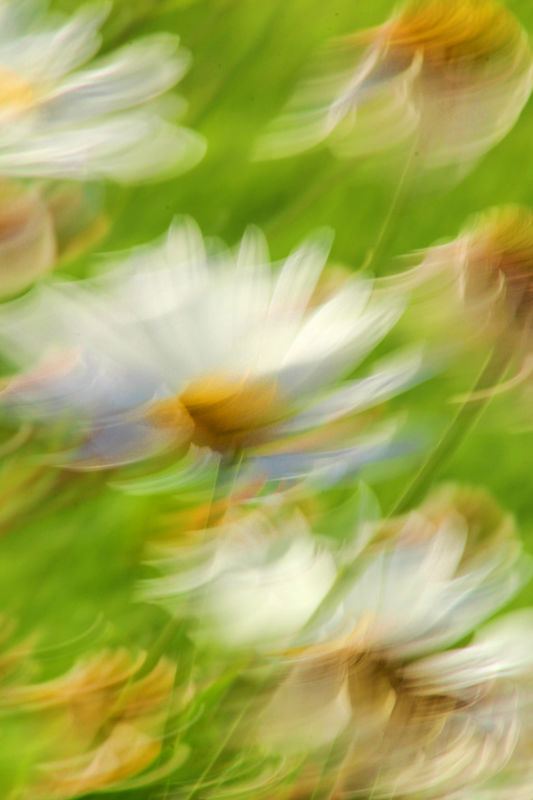
May 1, 2019 19:17:04 #
Linda From Maine wrote:
Coincidentally, I have a photo of lily pads, with ... (show quote)
Thank you Linda, for sharing your thoughts on what sounds like impressionistic interpretations of photos. I welcome you to share as many as you’d like. There are multiple ways to demonstrate some of these artistic principles with software, camera work, and combinations of both. That is a lovely example you’ve shared here, the sort of image that makes a viewer feel good just to look at it!
And of course you know I share your thoughts about creative interpretations being fun to look at and fun to work with.
May 1, 2019 19:39:07 #
I posted a couple in PP Forum that may be closer to a recognizable Impressionistic style, but this was my favorite of my afternoon's efforts. Thanks again for the inspiration, Minnie!
May 2, 2019 17:59:49 #
A delightfully intriguing and thought provoking article!
Thanks for sharing!!!
Thanks for sharing!!!
May 3, 2019 16:08:54 #
It seems to me that where Monet and Impressionism are concerned, there's a recurring theme of unintentionality. The critic that gave Impressionism its name did so unintentionally. And apparently Monet's eye condition caused him to see colours inaccurately, resulting in a pronounced blue tint in some of his paintings, which was unintentional. I also suspect that it was his eye condition that influenced his style of painting by making it difficult for him to see much in the way of detail - hence the preference for portraying form and light - the stuff that he could see clearly enough to reproduce. So the person that originated Impressionism never had that specific intention.
I think we see in Monet's paintings the very roots and the very beginnings of Impresionism. I would say that the real nature of Impressionism didn't emerge until the style had been developed and refined. I would say we have to look to the likes of Turner to see the essence of Impressionism. For that reason I wouldn't have one of Monet's waterlily paintings on my wall- I don't see them as being exemplary. That's not to say that Monet's role wasn't influential.
To my mind there is very little difference between photographers and painters/sketchers. I would say the goals are pretty much identical. The difference lies in the method. The photographer uses a method that doesn't require the same skills that the painter/sketcher requires. And that applies to the realistic pursuits as well as the impressionistic pursuits.
I've only ever done a few impressionistic edits, mainly because my main interest has always been to learn how to optimise and fix my photos which are predominantly realistic. I'll post one of my early attempts to de-prioritise realism and to portray an essence of an impression ( ).
).
-
I think we see in Monet's paintings the very roots and the very beginnings of Impresionism. I would say that the real nature of Impressionism didn't emerge until the style had been developed and refined. I would say we have to look to the likes of Turner to see the essence of Impressionism. For that reason I wouldn't have one of Monet's waterlily paintings on my wall- I don't see them as being exemplary. That's not to say that Monet's role wasn't influential.
To my mind there is very little difference between photographers and painters/sketchers. I would say the goals are pretty much identical. The difference lies in the method. The photographer uses a method that doesn't require the same skills that the painter/sketcher requires. And that applies to the realistic pursuits as well as the impressionistic pursuits.
I've only ever done a few impressionistic edits, mainly because my main interest has always been to learn how to optimise and fix my photos which are predominantly realistic. I'll post one of my early attempts to de-prioritise realism and to portray an essence of an impression (
 ).
).-
May 3, 2019 18:22:12 #
Crichmond wrote:
A delightfully intriguing and thought provoking article!
Thanks for sharing!!!
Thanks for sharing!!!
Thanks for dropping by, and do feel free to take a shot at any of the questions or share an image of your own in this thread, that's what it's for!
May 3, 2019 18:25:59 #
R.G. wrote:
It seems to me that where Monet and Impressionism ... (show quote)
Thanks for your detailed reply RG, and for your thoughtful consideration of some new trails to follow to understand Monet and his place in the impressionist movement. As someone who's had visual deficits that went uncorrected for years, I agree with you that some of what he painted may well have been what he saw as well as how he interpreted it.
Your dandelion is richly beautiful. The editing seems Orton-like. That's one of my favorite effects, and I do think Orton was an "impressionistic photographer" if there is such a term. In the current day, William Neill has some excellent impressionistic photography in his portfolio.
May 6, 2019 15:05:13 #
A couple I did up in software especially for this thread, followed by one I did with camera (shot a reflection and turned it upside down) last fall.
May 6, 2019 15:37:11 #
minniev wrote:
Upside down reflections are always so much fun to explore. But your first two are absolutely exquisite. Breathtaking results, Minnie!A couple I did up in software especially for this thread, followed by one I did with camera (shot a reflection and turned it upside down) last fall.
May 6, 2019 15:59:04 #
minniev wrote:
A couple I did up in software especially for this thread, followed by one I did with camera (shot a reflection and turned it upside down) last fall.
Green lily pads on greenish water is a rendering I can relate to. In #3 the ripple/reflection effect captures the "open water" look of that sort of scene. In #2 the context would appear to be the green world of plants, so presumably that's "mission accomplished" as well.
With Impressionism I think it's a question of how far you want to go down the rabbit hole. Is it enough to just distance yourself from a realistic rendering or does your alternative rendering have to "say" something about the nature of what you're portraying? The more we lean towards the latter the more important it is for our distortions and departures from realism to be appropriate for the subject, in the sense of bringing out something of the character or essence of the subject.
Perhaps the world of impressionism tries to accommodate both approaches. Any departure from realism can be seen as Impressionism, but if you want to go further with your interpretations and reveal something of the nature or essence of the subject, the sky's the limit. Or is it less anarchic than that?
Perhaps somebody has already defined the difference between "Impressionist" and "Surreal"...
May 6, 2019 16:20:48 #
Linda From Maine wrote:
Upside down reflections are always so much fun to explore. But your first two are absolutely exquisite. Breathtaking results, Minnie!
Thanks Linda!
May 6, 2019 16:28:33 #
R.G. wrote:
Green lily pads on greenish water is a rendering I... (show quote)
When I was a kid, we summered at the beach in a cottage we rented from an old German man who spoke few words, and with an accent and a lisp. I once asked him what fall and winter were like there. He answered "sunsets iss so pretty, make me wiss I was a painter". That stuck with me about all of nature. I always wished I could paint, even persuaded my parents to let me try lessons, but to no avail.
So, I think impressionistic interpretations of photos are, for me, an effort to portray what the scene would have evoked for me if I "was a painter". I feel no less chained to realism using photography as part of my image than my cousin does with her paints and pastels. I understand that others feel differently, which is fine with me.
May 7, 2019 13:22:26 #
I found it interesting that in its beginnings, Impressionism was all about painting outdoors, "on the spot" (as opposed to a studio indoors) and one of the main objectives was capturing the often transient effects of daylight. Since some of those effects were very transient, speed was often of the essence and realism was seen as being expendable. The process of capture could be speeded up if the objective became that of capturing an impression rather than a realistic rendering. The objective of capturing an impression therefore came about as a result of necessity rather than being an original and guiding objective.
Your comments about what impressionistic edits mean to you got me thinking about art in general. It seems to me that at this point in time, most painters would say that painting just for realistic effect is merely a demonstration of manual skills, and painting is really all about portraying what a scene or subject evoked in them. I suspect that that has been part of the mind-set of most painters down through the generations, and Impressionism was an attempt to restore that aspect of the art at a time when it was in danger of being lost to realism. However, even the Impressionists recognised that we couldn't completely disregard the need for at least some realism if we wanted to avoid art becoming completely fantastical (whimsical? chaotic?). So what the Impressionists did is restore the balance by emphasising what was in danger of being lost if the trends of their time continued the way they were going.
It then occurred to me that if the need for speed had been met in some other way - for instance through photography - Impressionism as a balancing influence may never have emerged because photographers wouldn't have had to limit themselves to capturing just an impression. They could have captured the full reality, regardless of how fleeting it may have been. And that left me wondering if we would have still achieved our more balanced and open-minded attitude to art and what can be called art.
Your comments about what impressionistic edits mean to you got me thinking about art in general. It seems to me that at this point in time, most painters would say that painting just for realistic effect is merely a demonstration of manual skills, and painting is really all about portraying what a scene or subject evoked in them. I suspect that that has been part of the mind-set of most painters down through the generations, and Impressionism was an attempt to restore that aspect of the art at a time when it was in danger of being lost to realism. However, even the Impressionists recognised that we couldn't completely disregard the need for at least some realism if we wanted to avoid art becoming completely fantastical (whimsical? chaotic?). So what the Impressionists did is restore the balance by emphasising what was in danger of being lost if the trends of their time continued the way they were going.
It then occurred to me that if the need for speed had been met in some other way - for instance through photography - Impressionism as a balancing influence may never have emerged because photographers wouldn't have had to limit themselves to capturing just an impression. They could have captured the full reality, regardless of how fleeting it may have been. And that left me wondering if we would have still achieved our more balanced and open-minded attitude to art and what can be called art.
May 18, 2019 15:29:48 #
If you want to reply, then register here. Registration is free and your account is created instantly, so you can post right away.

